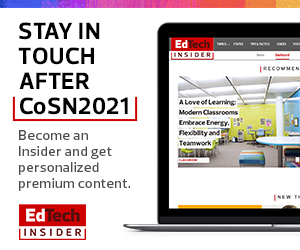What Are the Biggest Hurdles Facing K–12 Education?
Of the many challenges it explored, the advisory board voted on digital equity, scaling and sustaining innovation, and the evolution of teaching and learning as the top three hurdles in K–12 education.
- Digital Equity: This was seen as the most important hurdle, Jackson explained. Digital equity has different components, each of which are hurdles for educators to overcome. Foundational elements, such as equitable internet access, have to exist in order to support learning, she said. “You may have the internet and not a device, or you may have a device and not the internet,” Jackson said.
Beyond that, schools must ensure that all students have the knowledge and skills to use the technology and services, she explained, “so that they can interact with robust and accessible content.”
- Scaling and Sustaining Innovation: While digital equity was perceived as the most notable hurdle in 2021, the board pinpointed scaling and sustaining innovation as the hardest to overcome.
Jackson explained that pockets of innovation within each school district are often difficult to efficiently scale across entire school systems. It can be costly to expand innovation within a district, and finding support for that investment can be a challenge, especially when trying to scale and adapt projects to the district, state or global level, she said.
- Evolution of Teaching and Learning: Because teaching, learning and the outcomes of both are constantly evolving, schools are tasked with ensuring that teaching practices intentionally incorporate advances in technology, Jackson noted. She emphasized the importance of professional development for all teachers, and stressed that they should be engaged in meaningful, professional and innovative learning practices to develop their skills.
READ MORE: How to close the professional development gap in K–12 education.
How Can K–12 Education Accelerate Innovation?
The advisory board also analyzed trends for accelerating innovation, with a focus on overcoming K–12 educational challenges. Personalized learning, social and emotional learning, and learner autonomy were ranked by the board as the top three accelerators.
- Personalized Learning: The global advisory board deemed personalization the most important — and most powerful — way to boost digitally supported teaching and learning, Waba said.
“Schools are finding ways to provide learning support at the individual level,” he explained, noting steps schools can take, such as including personalized learning time. This practice, Waba says, allows students to work individually on projects or activities that are personal for each learner.
- Social and Emotional Learning: The pandemic exacerbated the need for emotional learning, Waba explained, because people react differently in times of crisis. “Teachers themselves need to deal with their own emotional needs but also need to deal with a student’s emotional needs,” he said.
Waba also spoke about the board’s discussions regarding the importance of transforming negative emotional energy into positive and constructive energy.
- Learner Autonomy: Hand in hand with the other two accelerators, learner autonomy is all about letting students decide how they want to learn. Waba explained that educators must enable students to make the choice and then support their exploration. “Some teachers may fear losing control,” Waba said of the challenges around learner autonomy, adding that “a change of mind is needed.”
MORE ON EDTECH: Academic, social boosts show esports are more than just games.
What Type of Technology Can Help K–12 Education Overcome Challenges?
Technology enablers help grease the wheels for schools to overcome hurdles and leverage accelerators, Jackson explained. The advisory board settled on digital collaboration environments, untethered broadband and connectivity, and blended learning tools — three technologies that support one another — as the top three technology enablers in 2021:
-
Digital Collaboration Environments: “Think of it as a way to provide more personalized learning for students and to diversify learning activities and give students more time,” Jackson said of digital collaboration environments, which he said can support collaboration online and in person.
-
Untethered Broadband and Connectivity: This focuses on the infrastructure that supports schools and learning, Jackson explained. With untethered broadband and connectivity, she said, schooling doesn’t need to happen in physical school buildings, as learners have seen during the pandemic.
-
Blended Learning Tools: These include the technologies and pedagogy that enable learning experiences both face to face and online, Jackson said, emphasizing that this enabler is a major component of the other two. “These are tools that can be used strategically online and in person,” she stated.
EdTech is covering CoSN2021, so keep this page bookmarked for our ongoing coverage. Follow @EdTech_K12 on Twitter for live updates and join the conversation using #CoSN2021.











